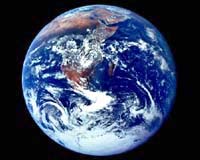
 |
This flat, wind-whipped country resting on the back of 400 islands is now pulling ahead as the dominant player in the growing and technologically challenging market of off-shore wind turbines.
There "is a potential to raise wind turbines totaling 100,000 megawatts along the entire European coast, especially in the Baltic Sea and in the North Sea. That's four times the power of wind turbines installed on European land" today, according to Danish energy market analysis firm BTM Consult.
The Danish wind power industry, which employs 20,000 people, sold a total of 3,200 megawatts of wind power in 2003 out of a total global production of
With its 5.4 million inhabitants, Denmark also proudly tops world consumption of wind power, with 21.1 percent of its total electrical consumption produced in wind turbines in June 2004. That compares to a mere six percent in neighboring Germany and 0.5 percent globally.
Denmark was the first country to use wind energy for electricity production. As early as 1891, Danish meteorologist Poul La Cour experimented with a generator hooked up to a windmill which he used to provide his school with lights -- a groundbreaking discovery which earned him the title "pioneer of modern aerodynamics".
It was not until 1979, however, that the Danish wind power adventure really began, as the second worldwide oil crisis, following one in 1973, forced the Danish government to look for alternative sources of energy, according to Birger Madsen, co-head of BTM Consult.
"They subsidized the installation of wind turbines by 30 percent in an attempt to reduce their huge dependence on oil, which represented 90 percent of the country's total energy consumption," he told AFP.
Danish wind turbine builders subsequently increased their lead over competitors, aggressively grabbing market share between 1983 and 1986 in the United States, which at the time represented 90 percent of the world market.
Even though US and Spanish companies, such as General Electric Wind Energy and Gamesa, have recently been nipping at their heels, Danish companies, led by Vestas Wind System, have remained the industry powerhouses, controlling between 40 and 50 percent of global wind turbine sales.
Earlier this year Vestas swallowed rival NEG Micon, boosting its global market share to 35 percent, and allowing it to rake in a 2.6-billion-euro (3.2-billion-dollar) turnover in 2004 alone.
Despite a number of uncertainties weighing on the US wind turbine market and the fact that the global market seems to have stagnated this year after soaring 15 percent in 2003, Danish producers remain optimistic.
They are putting their "faith in their expertise and their technology, constructing more and more powerful turbines, (and are) breaking into new markets like Austria and Great Britain", Hanne Jersild, a consultant with the wind turbine industry organization, told AFP.
In fact, the Danish wind energy industry is doing so well that producers are running out of space on land to put their turbines and have begun creating off-shore turbine parks.
The Scandinavian country has already built two such parks, the largest in the world: Horn Rev near Esbjerg to the west, turning out 160 MW, and Roedsand near Nysted to the east with 165.6 MW.
And the Danish government recently decided to build two new parks by 2009 with a combined power output of 400 MW, claiming they will help reduce the country's carbon dioxide emissions.
For each megawatt per hour of power produced in wind turbines instead of from coal or oil, carbon dioxide emissions are reduced by 0.8-0.9 tonnes annually.
This makes wind power an attractive solution for the European Union, for instance, which has in accordance with the 1997 Kyoto protocol committed to reducing its emissions by eight percent on average by 2012, from 1990 levels, and for Denmark which has said it will slash its output by 21 percent.
While wind turbine parks at sea are expected to greatly increase wind power production, their output on a global scale is expected to remain meager for some time to come, researchers say.
"Denmark, with 750 MW installed at sea from now through 2009 would represent little on the world market. But it's a laboratory, a technological display window for Danish producers to land orders from Great Britain and Germany," Madsen said.
Britain is currently planning to build offshore turbine parks with a 7,000 MW output, and Germany has said it will create turbine parks pumping out at least 2,000 MW by 2010.
TERRA.WIRE |